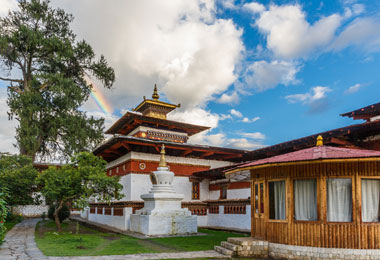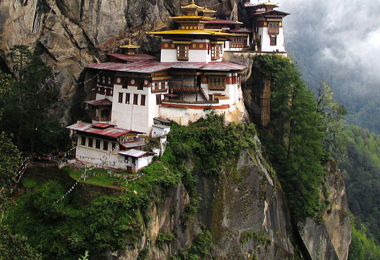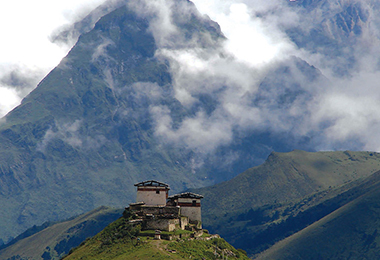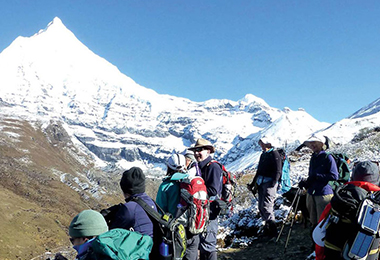
10 Days Jomolhari Loop (Soi Yaksa) Trek
(BTT005) Paro - Gunitsawa Village - Sharna Zampa - Thangthangkha - Jangothang - Soi Yaktsa - Thombu Shong - Gunitsawa Village - Paro
-
Tour Type:
Escorted by private guide and vehicle; leave 365 days a year!
-
Trip Level:
Moderate - suitable for ones with average level fitness, family with kids bigger than 12 yrs.
-
Trip Level Guide:
- Easy - suitable for all level of fitness, family with kids and senior groups.
- Moderate - suitable for ones with average level fitness, family with kids bigger than 12 yrs.
- Moderate to Strenous - suitable for ones physically fit; have experiences of high altitude trek.
- Strenuous: suitable for adventures and individual with physically fit and healthy.
-
Season:春
Spring夏
Summer秋
Autumn冬
Winter
Overview
Among the tremendous classic trekking routes, Jhomolhari Loop Trek is no doubt one of the most popular medium-level treks in Bhutan and enjoys large popularity in hike lovers all around the world.
The trek starts from Gunitsawa village located in the northwest of the country nearby the border of Bhutan and China, and goes northwardly to reach Jangothang, the best camping place in all Himalaya regions. Then the trail makes a swerve and takes a roundabout route back to the starting place Gunitsawa village after passing some beautiful highland trout-filled lakes and stunning flower meadows.
If you fancy a fantastic panoramic view of majestic Mt. Jhomolhari and Mt. Jichu Drakye of Himalaya Range, and bother to take a frustrating trek to Lingzhi, then this loop trek is perfect for you. Stunning Himalaya Range is paralleling with the route you trek, solemn world-class mountains are at hand. Rocky cliffs, wildflower meadows, pure lakes provide all the possibilities for you to explore.
Difficulty: Medium
Max Elevation: 5,000 m
Min Elevation: 2,500 m
Best season: April, May, June, September, October, November
Duration: 10 days
At a Glance
Day 1Paro Arrival (2,200 m)
Day 2Paro (2,200 m) - Gunitsawa Village (2,930 m)
Day 3Gunitsawa Village (2,930 m) - Sharna Zampa (2,890 m)
Day 4Sharna Zampa (2,890 m) - Thangthangkha (3,575 m)
Day 5Thangthangkha (3,575 m) - Jangothang (4,044 m)
Day 6Jangothang Halt (4,044 m)
Day 7Jangothang (4,044 m) - Soi Yaktsa (3,800 m)
Day 8Soi Yaktsa (3,800 m) - Thombu Shong (4,180 m)
Day 9Thombu Shong (4,180 m) - Gunitsawa Village (2,930 m), Drive to Paro (2,200m)
Day 10Paro (2,200 m), Departure
Day to Day Itinerary
Day 1: Paro Arrival (2,200 m)
Arrival by plane or driving to Paro from Phuntsholing after crossing the India-Bhutan Border. Sighting according to the arrival time.
Stay overnight in Paro hotels
Day 2: Paro (2,200 m) - Gunitsawa Village (2,930 m)
Distance: 16 km
Ascent: Ascent: 630 m
Camp Altitude: 2,890 m
Drive to Gunitsawa village from Paro. Tourist bus stops temporarily at the intermediate stations where the scenery sites locate. Morning visit of Kyichu Lhakhang, the temple built in 8th century by Tibetan king Songtsen Gampo. Climb to Taktsang Gompa known as Tiger's Nest, the most venerated and holy place in Bhutan and take an overlook of the valley from a steep cliff.
After lunch the bus will drive you to Drukyel Dzong, the place used to be the starting point of this trek. Visit the ruins of the old dzong and further ascend to military camp of Gunitsawa on the newly built road. Camp the first night just above military camp.
Camping at Gunitsawa
Day 3: Gunitsawa Village (2,930 m) - Sharna Zampa (2,890 m)
Distance: 2 km
Time: 25 mins
Ascent: Descent 80 m
Camp Altitude: 2,850 m
This trek starts at Gunitsawa, a small but beautiful village not far from the army post. Before passing through this post, your trekking permit is due to be checked, so get this permit prepared (Our tour operator will help you get it ready in advance).
Camping at Sharna Zampa
Insider tips:
Have a good rest at the campsite on the opposite side of the river not far from Gunitsawa, for tomorrow’s trek becomes physically consuming.
Day 4: Sharna Zampa (2,890 m) - Thangthangkha (3,575 m)
Distance: 22 km
Time: 7-8 hours
Ascent: Ascent 685 m, descent 10 m
Camp Altitude: 3,610 m
Flanked by lush conifers and rhododendrons, the river Paro Chuu points you the way you are about to explore. Heading northwardly, you arrive at Shing Karap, a characteristic stone house at the elevation of 3,110 m after you passing through Jigme Dorji National Park, which is symbolized by a remnants of an old bridge with a house and a chorten.
Then continue to follow the trail to reach Tremo La (4,380 m), where the trail bifurcates. Don’t choose the left one, since it is an ancient trail leading to Tremo La, the old trade route from Phari Dzong in Tibet.
The stone-paved trail stretches with moderate ups and downs through dense forests of birch and fir flowed by blue pines, and eventually arrives at a meadow where our campsite is set up. Standing on the campsite, you can have a fantastic panoramic view of Jomolhari Mountain looming in front of your eyes.
Camping at Thangthangkha
Day 5: Thangthangkha (3,575 m) - Jangothang (4,044 m)
Distance: 19 km
Time: 5-6 hours
Ascent: Ascent 480 m
Camp Altitude: 4,080 m
If you miss the sunset of Mt. Jomolhari, then don’t let slip the spectacular sunrise of the mountain in the early morning. Get fully packed and continue to follow the trail along the Paro Chhu to get today’s trekking started. You will cross an army checkpoint where rough stone barracks are set up. Today, you still have the chance to enjoy a spectacular view of mountain ridges and snow-capped peaks.
The ascending trail brings you to the village of Soe after passing through the larch covered hillside. Then the view has suddenly changed, and the scenery of locals herding yaks pops into your eyes. If you are worried about having not met any highland hamlet along the route, then a cluster of stone houses on a plateau at 3,940 m will soon bump into your eyes after a one-hour trek to Takethang.
Dangochang is another village you are bound to cross before your final arrival at Janothang Base Camp. Villagers here are lived by yaks and sheep they raise and vegetables like potato, turnip, and radish they grow. Don’t miss the chance to experience the primitive life with the locals here.
The Trail goes upwardly to reach Jangothang at the altitude of 4,080 m, where a fantastic campsite can be found and a view of majestic Jomolhari is near at hand.
Camping at Jangothang Base Camp
Insider tips:
As the elevation of the trekking trail goes higher in this day, you need to slow down your hiking steps accordingly, since today’s trek will ascend to the places that can cause altitude sickness.
Day 6: Jangothang Halt (4,044 m)
The rest day or we call it the exploration day in Jangothang provides all possibilities for visitors to arrange a day hike to a nearby campsite. It is also regarded as the best day for acclimation if you plan an ascent to a higher place in Lingzhi.
There are four major trails you are recommended to take for further exploration from Jangothang. The first and the best route comes to a four-hour excursion up to the north of the camp, where after one hour’s walk you can get a splendid view of Jichu Drakye. The second option is to choose Mount Jomolhari which lies directly to the west. Or you can also ascend the numerous unclimbed mountains to the east.
Besides the listed excursion trails, here has another option waiting to be picked up. You can take an expedition to Tshophu, an eminent trout-filled lake located along the route of Jomolhari Loop Itinerary. It only takes one and a half hours to reach there.
Camping at Jangothang Base Camp
Day 7: Jangothang (4,044 m) - Soi Yaktsa (3,800 m)
Distance: 16 km
Time: 6-7 hours
Ascent: Ascent 810 m, descent 1,090 m
Camp Altitude: 3,800 m
From Jangothang, you begin your return trip by another route heading south to form the entire loop. The trail leads to a last settlement in the valley and drops to the Paro Chhu.
The trail climbs up to the highest point of this trek, Bhonte La Pass, at 4,890 m after you passing the lakes of Tshophu (4,380 m), the high-altitude lakes eminent for the inhabited ruddy shelducks and the deep-lake brown trout. Fascinating panoramic views of Jhomolhari, Jhomolhari 2, Jichu Drakye and Tserim Kang are along the trekking route.
Passing the lake, you start to trek downstream and eventually reach Soi Yaktsa (3,800 m), a spectacular valley with stunning views perfect for the campaign after you wind down a stretch of yak trail. Have a good rest at Soi Yaktsa to enjoy the rocky cliffs, meadows, wildflowers, and nomadic settlements.
Camping at Soi Yaktsa valley
Insider tips:
Through this day, you are supposed to keep your eyes open on the regional wildlife inhabited here. Once a flock of blue sheep, a group of marmots or a group of rarely seen snow leopards are found, don’t miss the chance to take the picture with these primitive animals.
Day 8: Soi Yaktsa (3,800 m) - Thombu Shong (4,180 m)
Distance: 11 km
Time: 4-5 hours
Ascent: Ascent 720 m, descent 340 m
Camp Altitude: 4,180 m
Today’s trail begins from an uphill climb after you pass a short stretch of trail with lush rhododendrons by the hillside. You still trek in forests of birch and oak after you arrive at a chorten and a mani wall.
You can choose to follow the mani wall and take a upward trail to a small valley where the trekking trail bifurcates, or you can choose to take a quick downward tour to the ruins of the Sey Dzong and then go back to the main trail to reach the small valley.
Pick the right track at the small valley to reach the Takhung La Pass (4,520 m). Spectacular views of Jomolhari, Jichu Drakye, and Tserim Kang appear again in all their splendors.
After the Takhung La Pass, the trail starts to descend till you arrive at Thombu Shong, green pasture with three yak herder huts scattering around. Your campsite is next to them.
Camping at the green pasture of Thombu Shong
Insider tips:
If the weather is clear, you can get an amazing panoramic sight of the formidable Kanchenjunga Mountain (8,586 m), the third highest mountain in the world and lying between Nepal and Sikkim at Takhung La Pass.
Day 9: Thombu Shong (4,180 m) - Gunitsawa Village (2,930 m), Drive to Paro (2,200m)
Thombu Shong to Gunitsawa Village
Distance: 13 km
Time: 4-5 hours
Ascent: Ascent 200 m, descent 1,650 m
Camp Altitude: 2,850 m
Gunitsawa Village to Paro
Distance: 16 km
Ascent: Descent 630 m
Leaving the campsite, the trail begins to gain elevations to reach the Thombu La Pass (4,380 m) after you pass through a gorgeous garden festooned with beautiful wildflowers and flush rhododendron.
Passing the Thombu La, you will be guided by a steep downward route to Gunitsawa village (2,730 m), where you can choose to end this trek here.
Insider tips:
Cease your steps at Thombu La Pass for the last look at the majestic Mt. Kanchenjunga (8,586 m) and Drakye Gang (5,200 m).
Day 10: Paro (2,200 m), Departure
Depart from Paro Airport
Service Guide
Service Included:
- A minimum of 3 star accommodation (4 & 5 star may require an premium payment);
- All meals specified in the itinerary;
- Airport transfer, private transport for sightseeing in Bhutan;
- Experienced driver;
- An English-speaking and licensed Bhutanese tour guide for the extent of your stay;
- Entry fee and road permits;
- Government fee, royalty, taxes;
- Bottled mineral water throughout the journey.
Service Excluded:
- Bhutan Visa Fee;
- International flight to and out of Bhutan;
- Personal expenses such as drinks, postage, and laundry, etc.;
- Travel insurance in Bhutan;
- Emergency evacuation;
- Tips and gratuities;
- Costs arising from unforeseen events;
- Extra activities like cultural show, kayaking, etc.
Contact us for your dream trip now !
Enquire NowYou May Also Like
-
 3 Days Classic Bumthang Culture Trek
3 Days Classic Bumthang Culture TrekToktu Zampa - Ngang Lhakhang - Tahung - Mesithang
-
 3 Days Bumthang Owl Trek
3 Days Bumthang Owl TrekMenchugang - Dhur Village - Drangela Pass - Tharpaling Goemba
-
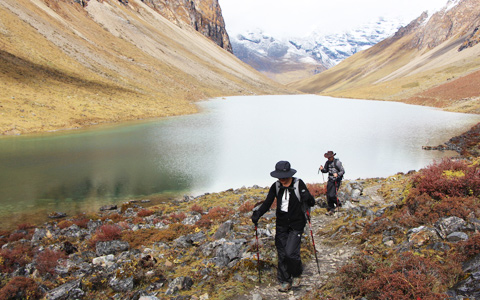 6 Days Dagala Thousand Lakes Small Group Trek
6 Days Dagala Thousand Lakes Small Group TrekGeynizampa - Gur - Labatamba - Panka - Talakha - Chamgang
-
 6 Days Most Popular Druk Path Trek in Bhutan
6 Days Most Popular Druk Path Trek in BhutanParo - Jili Dzong - Jangchhu Lakha - Jimilang Tsho - Simkotra Tsho - Phajoding - Motithang

The trek takes you to the amazing Jomolhari Base Camp at Jangothang along the spectacular trail from which splendid panoramic view of Bhutan Himalaya can be sighted. Keep your eyes trained on wilderness, for the bumping of some rarely-seen animals into your eyes brings you excitement.
Tibetan Travel Guru,Master Kungga Dundruk
Get A Quotation of this Tour
Get Started - 10 Days Jomolhari Loop (Soi Yaksa) Trek
You’re getting closer to your dream Tibet vacation! Fill out this form so our travel designers can start helping you plan a trip.
Privacy Policy: Your information is kept strictly confidential. Tibet Vista will never sell, trade, or give away your contact information to a third party.

.jpg)


-Trek376.jpg)
